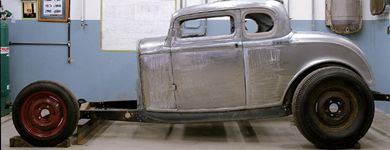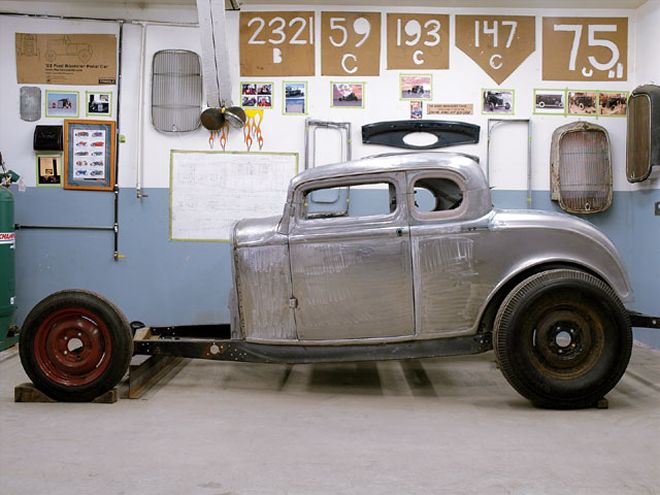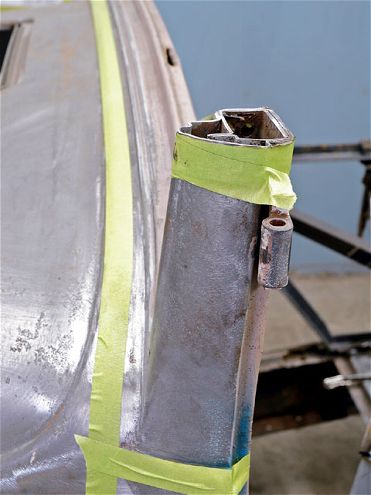

Setting out to work with metal that has endured 75 years of unknown punishment is a task best taken on by craftsmen who are driven by the countless challenges that they will encounter on the journey. For anyone altering one of Henry's finest designs, the pendulum swings really close to their necks, 'cuz you'd better be on the right path if you're messing with an original Deuce. The crew at Rolling Bones Hot Rod Shop is well-known for being able to stare the Devil square in the face, shower him with sparks, and come out winners with their crafty fabrication skills, so there was no better choice than to have them do the honors in whacking the lid off George Poteet's latest hot rod.
When we last left off, Keith Cornell of Rolling Bones, with help from crewmembers Ken Schmidt and Chris Chabre, had just finished removing the top and finessing quite a bit of vintage steel on the coupe. Keith reminded us last time that the initial impression of just where a chop might go was based on a fixed starting point-in this case, 5 inches-and the subsequent placement of the roof on and off the car dozens of times until everything was trimmed perfectly to give the car what it needed. By the time all of the trimming was said and done in the case of George's coupe, the chop had grown to 6 inches up front with a progression to 5 1/2 inches out back, giving the coupe a radical half-inch wedge and loads of attitude in the process. Ken eloquently stated during the chop that they strive to give each and every one of their cars a unique personality that will follow it as it goes down the road in its next life.
 Keith uses 3/4-inch masking tape to mark off the areas of the cowl that will receive a number of cuts as the chop proceeds.
Keith uses 3/4-inch masking tape to mark off the areas of the cowl that will receive a number of cuts as the chop proceeds.
As we pick up on this second and final part of the chop, there are a number of tricky areas that will be addressed in order to bring the chop into its ultimate correct proportions, giving the car a factory-fresh look. The first of these problematic areas to be addressed is the cowl, since the realignment of the A-pillars with the top is critical. A careful study of the cowl proved that a cut across its reveal area from left to right would allow a slight rake to be infused into the mix where the laying-back of the A-pillar posts would have them gracefully meet up with the roof section. Three-eighths of an inch might not seem like much, but it makes all the difference in a world governed by proportions.
With the cowl area well on its way to completion, after facing subsequent cutting and trimming including modifications to the top pillars, Keith had to focus on the doors and what it would take to bring them back on track with the progression of the chop. They would need to reflect the gradual wedge that the top received during the chop and thus required some major surgery. The doors would need to not only have their initial 5 inches removed to flawlessly match up with the freshly laidback A-pillars, but additionally they needed to have their upper hinge areas removed and reworked to reflect the wedge and laidback A-pillars. With that said and done, the side view of the coupe's body now gained a perspective that further dialed in the evilness that the car was earning.
Saving the best for last, there were definitely some serious proportional issues facing Keith as he made his way to the rear of the car. With the top coming down 5 1/2 inches out back, the rear sail panel was in need of a number of relief cuts to be able to realign the top and base of the body so their proportions would blend perfectly once again. Proper clamping and initial tack-welding gave Keith a lead on accurately lining up the panels as each relief cut was marked and made. In all, three cuts per side did the trick and the sail panels started to regain their factory curvature as they were reintroduced to each other with Keith's well-traveled skills with a hammer and dolly.
The final wrap on the chop was removing a lower rear quarter-window section that needed to be extended a quarter-inch due to the realignment encountered from the chop. The transition on its reinstallation was seamless with the utilization of a section of steel that had been removed from the sail panel. With everything finally tacked solid, the coupe gave off an eerie aura that seemed to let you know right away that it was going to be a force to be reckoned with. For us, studying the dead-on side shot of the car told the story full-throttle, where the newfound proportions that the coupe earned were enhanced thanks to the rear-wheel placement in its perfect spot, accented by a gradual stretch to the wheelbase in the neighborhood of 110 inches. Stay tuned, 'cuz this isn't the last that you've seen of this sinister coupe brewing at the Rolling Bones Hot Rod Shop.